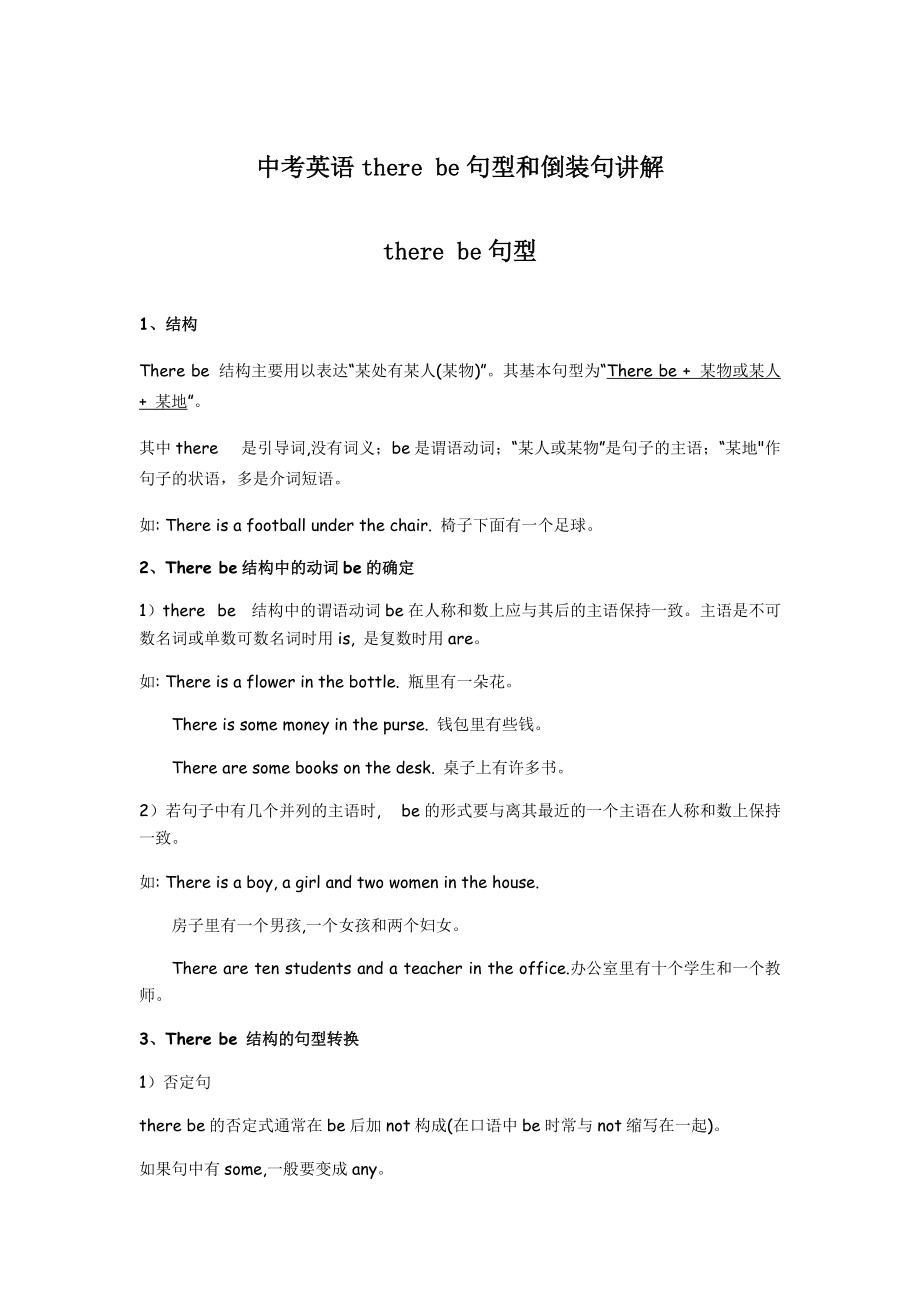《初中英語(yǔ)知識(shí)點(diǎn):there be句型和倒裝句》由會(huì)員分享,可在線閱讀�,更多相關(guān)《初中英語(yǔ)知識(shí)點(diǎn):there be句型和倒裝句(3頁(yè)珍藏版)》請(qǐng)?jiān)谘b配圖網(wǎng)上搜索。
1����、中考英語(yǔ)there be句型和倒裝句講解
there be句型
1�����、結(jié)構(gòu)
There be 結(jié)構(gòu)主要用以表達(dá)“某處有某人(某物)”�。其基本句型為“There be + 某物或某人 + 某地”�。
其中there 是引導(dǎo)詞,沒(méi)有詞義;be是謂語(yǔ)動(dòng)詞���;“某人或某物”是句子的主語(yǔ)����;“某地"作句子的狀語(yǔ)��,多是介詞短語(yǔ)��。
如: There is a football under the chair. 椅子下面有一個(gè)足球�����。
2����、 There be結(jié)構(gòu)中的動(dòng)詞be的確定
1)there be 結(jié)構(gòu)中的謂語(yǔ)動(dòng)詞be在人稱和數(shù)上應(yīng)與其后的主語(yǔ)保持一致。主語(yǔ)是不可數(shù)名詞或單數(shù)可數(shù)名詞時(shí)用is, 是
2�����、復(fù)數(shù)時(shí)用are�。
如: There is a flower in the bottle. 瓶里有一朵花。
There is some money in the purse. 錢包里有些錢����。
There are some books on the desk. 桌子上有許多書(shū)。
2)若句子中有幾個(gè)并列的主語(yǔ)時(shí), be的形式要與離其最近的一個(gè)主語(yǔ)在人稱和數(shù)上保持一致���。
如: There is a boy, a girl and two women in the house.
房子里有一個(gè)男孩,一個(gè)女孩和兩個(gè)婦女���。
There are ten studen
3、ts and a teacher in the office.辦公室里有十個(gè)學(xué)生和一個(gè)教師�����。
3�、There be 結(jié)構(gòu)的句型轉(zhuǎn)換
1)否定句
there be的否定式通常在be后加not構(gòu)成(在口語(yǔ)中be時(shí)常與not縮寫在一起)。
如果句中有some,一般要變成any���。
如: There are some children in the picture.
There aren't any children in the picture.
2)一般疑問(wèn)句及其答語(yǔ)
把be提到there前,首字母大寫,句末用問(wèn)號(hào)即可��。其肯定答語(yǔ)是Yes, there is / are;
4����、
否定答語(yǔ)為No, there isn't / aren't。
如: There are two cats in the tree.
—Are there two cats in the tree?
—Yes, there are. (No, there aren't.)
倒裝句
一�、部分倒裝
部分倒裝是指將謂語(yǔ)的一部分如助動(dòng)詞、情態(tài)動(dòng)詞或系動(dòng)詞倒裝至主語(yǔ)之前����。如果句子的謂語(yǔ)沒(méi)有助動(dòng)詞或情態(tài)動(dòng)詞,則需添加助動(dòng)詞do, does或did����,并將其置于主語(yǔ)之前。
倒裝的條件:
1. 句首為否定或半否定的詞語(yǔ)�����,如no, not, never, seldom, little,
5�����、 hardly, at no time, in no way, not until… �, not only... but also等。例如:
Never have I seen such a performance. 從未見(jiàn)過(guò)如此糟糕的表演。
Nowhere will you find the answer to this question. 無(wú)論如何你不會(huì)找到這個(gè)問(wèn)題的答案的�����。
Not until the child fell asleep did the mother leave the room. 母親一直到孩子入睡后離開(kāi)房間����。
當(dāng)Not until引出主從復(fù)合句�����,主句倒裝�����,從句
6�����、不倒裝�����。注意: 如否定詞不在句首不倒裝�����。例如:
I have never seen such a performance.
The mother didn't leave the room until the child fell asleep.
2. so, neither, nor作部分倒裝
用這些詞表示"也"、"也不" 的句子要部分倒裝���。例如:
Tom can speak French. So can Jack. 湯姆會(huì)講法語(yǔ)����,杰克也會(huì)��。
If you won't go, neither will I.你不去��,我也不去���。
3. only在句首倒裝的情況���。
Onl
7、y in this way, can you learn English well. 只有這樣�,你才能學(xué)好英語(yǔ)。
Only after being asked three times did he come to the meeting. 叫了三次���,他才來(lái)參加會(huì)議�。
如果句子為主從復(fù)合句�����,則主句倒裝,從句不倒裝�。例如:
Only when he is seriously ill does he ever stay in bed. 病得狠重時(shí),他才臥床休息��。
4. as, though 引導(dǎo)的倒裝句
as / though引導(dǎo)的讓步從句必須將表語(yǔ)或狀語(yǔ)提前(形容詞, 副詞, 分詞,
8��、 實(shí)義動(dòng)詞提前)����。但需注意:
1) 句首名詞不能帶任何冠詞��。
2) 句首是實(shí)義動(dòng)詞, 其他助動(dòng)詞放在主語(yǔ)后����。如果實(shí)義動(dòng)詞有賓語(yǔ)和狀語(yǔ),隨實(shí)義動(dòng)詞一起放在主語(yǔ)之前��。例如:
Try hard as he will, he never seems able to do the work satisfactorily. 他工作很努力��,但總不能讓人滿意�。
注意:讓步狀語(yǔ)從句中,有though�,although時(shí),后面的主句不能有but,但是 though 和yet可連用�。
5.其他部分倒裝
1) so… that 句型中的so 位于句首時(shí),需倒裝��。例如:
So frightened wa
9����、s he that he did not dare to move an inch. 他害怕得很,動(dòng)也不敢動(dòng)��。
2) 在某些表示祝愿的句型中���。例如:
May you all be happy. 愿你們都快樂(lè)�����。
3) 在虛擬語(yǔ)氣條件句中從句謂語(yǔ)動(dòng)詞有were, had, should等詞����,可將if 省略�,把 were, had, should 移到主語(yǔ)之前,采取部分倒裝�。例如:
Were I you, I would try it again. 我是你的話,就再試一次�����。
二、完全倒裝(謂語(yǔ)+主語(yǔ))
全部倒裝是將句子中的謂語(yǔ)動(dòng)詞全部置于主語(yǔ)之前����。此結(jié)構(gòu)通常只用于一般現(xiàn)在時(shí)和一般過(guò)
10、去時(shí)�����。常見(jiàn)的結(jié)構(gòu)有:
1. here, there, now, then, thus等副詞置于句首, 謂語(yǔ)動(dòng)詞常用be, come, go, lie, run等表示來(lái)去或狀態(tài)的動(dòng)詞���。例如:
Then came the chairman. 那時(shí)總裁來(lái)了。
Here is your letter. 你的信�。
2. 表示運(yùn)動(dòng)方向的副詞或地點(diǎn)狀語(yǔ)置于句首,謂語(yǔ)表示運(yùn)動(dòng)的動(dòng)詞�����。例如:
Out rushed a missile from under the bomber. 轟炸機(jī)肚底下竄出一枚導(dǎo)彈��。
Ahead sat an old woman. 前面坐著一個(gè)老嫗���。
注意:上述全部倒裝的句型結(jié)構(gòu)的主語(yǔ)必須是名詞�����,如果主語(yǔ)是人稱代詞則不能完全倒裝���。例如:
Here he comes.??他來(lái)了�����?��! ?
Away they went. 他們走開(kāi)了。
 初中英語(yǔ)知識(shí)點(diǎn):there be句型和倒裝句
初中英語(yǔ)知識(shí)點(diǎn):there be句型和倒裝句

